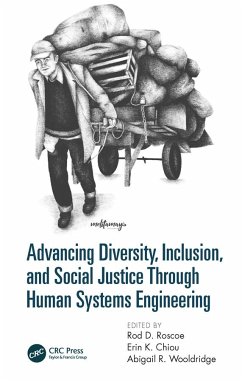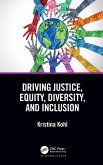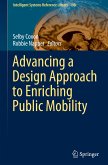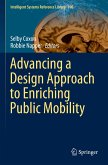Advancing Diversity, Inclusion, and Social Justice Through Human Systems Engineering
Herausgeber: Roscoe, Rod D.; Wooldridge, Abigail R.; Chiou, Erin K.
Advancing Diversity, Inclusion, and Social Justice Through Human Systems Engineering
Herausgeber: Roscoe, Rod D.; Wooldridge, Abigail R.; Chiou, Erin K.
- Gebundenes Buch
- Merkliste
- Auf die Merkliste
- Bewerten Bewerten
- Teilen
- Produkt teilen
- Produkterinnerung
- Produkterinnerung
Human factors research and practice, broadly defined, is relevant to designing for access and equity. This book will expand the discussion to specific themes of diversity, inclusion, and social justice. The book will educate readers about these ideas, promote additional research and practice, and guide future work.
Andere Kunden interessierten sich auch für
![Advancing Sustainability in Geotechnical Engineering Advancing Sustainability in Geotechnical Engineering]() Hong-Wei YangAdvancing Sustainability in Geotechnical Engineering126,99 €
Hong-Wei YangAdvancing Sustainability in Geotechnical Engineering126,99 €![Driving Justice, Equity, Diversity, and Inclusion Driving Justice, Equity, Diversity, and Inclusion]() Kristina KohlDriving Justice, Equity, Diversity, and Inclusion184,99 €
Kristina KohlDriving Justice, Equity, Diversity, and Inclusion184,99 €![Collaborative Research Advancing Engineering Solutions for Real-World Challenges Collaborative Research Advancing Engineering Solutions for Real-World Challenges]() Collaborative Research Advancing Engineering Solutions for Real-World Challenges85,99 €
Collaborative Research Advancing Engineering Solutions for Real-World Challenges85,99 €![Emerging Frontiers in Industrial and Systems Engineering Emerging Frontiers in Industrial and Systems Engineering]() Emerging Frontiers in Industrial and Systems Engineering221,99 €
Emerging Frontiers in Industrial and Systems Engineering221,99 €![Advancing a Design Approach to Enriching Public Mobility Advancing a Design Approach to Enriching Public Mobility]() Advancing a Design Approach to Enriching Public Mobility116,99 €
Advancing a Design Approach to Enriching Public Mobility116,99 €![Advancing Computing, Communication, Control and Management Advancing Computing, Communication, Control and Management]() Qi Luo (Hrsg.)Advancing Computing, Communication, Control and Management231,99 €
Qi Luo (Hrsg.)Advancing Computing, Communication, Control and Management231,99 €![Advancing a Design Approach to Enriching Public Mobility Advancing a Design Approach to Enriching Public Mobility]() Advancing a Design Approach to Enriching Public Mobility160,49 €
Advancing a Design Approach to Enriching Public Mobility160,49 €-
-
-
Human factors research and practice, broadly defined, is relevant to designing for access and equity. This book will expand the discussion to specific themes of diversity, inclusion, and social justice. The book will educate readers about these ideas, promote additional research and practice, and guide future work.
Hinweis: Dieser Artikel kann nur an eine deutsche Lieferadresse ausgeliefert werden.
Hinweis: Dieser Artikel kann nur an eine deutsche Lieferadresse ausgeliefert werden.
Produktdetails
- Produktdetails
- Verlag: CRC Press
- Seitenzahl: 308
- Erscheinungstermin: 17. Oktober 2019
- Englisch
- Abmessung: 240mm x 161mm x 21mm
- Gewicht: 628g
- ISBN-13: 9781138387980
- ISBN-10: 1138387983
- Artikelnr.: 58051807
- Herstellerkennzeichnung
- Libri GmbH
- Europaallee 1
- 36244 Bad Hersfeld
- gpsr@libri.de
- Verlag: CRC Press
- Seitenzahl: 308
- Erscheinungstermin: 17. Oktober 2019
- Englisch
- Abmessung: 240mm x 161mm x 21mm
- Gewicht: 628g
- ISBN-13: 9781138387980
- ISBN-10: 1138387983
- Artikelnr.: 58051807
- Herstellerkennzeichnung
- Libri GmbH
- Europaallee 1
- 36244 Bad Hersfeld
- gpsr@libri.de
Dr. Rod D. Roscoe is an Associate Professor of Human Systems Engineering, and a Diane and Gary Tooker Professor for Effective Education in STEM, at Arizona State University. His research identifies ways to improve educational efficacy and access by understanding relationships between learning theory, technology innovation, and user experience. He also investigates engineering education and the preparation of future engineers to address the 'human side' of engineering and design. Dr. Erin K. Chiou is an Assistant Professor of Human Systems Engineering at Arizona State University. Her research seeks to improve automation for more resilient and sustainable futures. Her work focuses on the social psychological factors in human-automation interaction and system design, with applications in complex and safety critical systems including defense and healthcare. She directs the Automation Design Advancing People and Technology laboratory. Dr. Abigail R. Wooldridge is an Assistant Professor of Industrial and Enterprise Systems Engineering at the University of Illinois at Urbana-Champaign. Her research aims to improve patient safety and quality of care as well as healthcare professional well-being. She analyzes and models complex sociotechnical systems and team cognition in healthcare to understand and improve how individuals with diverse backgrounds, perspectives, and training can work together across the patient journey.
Section 1: The Value of Diversity
Inclusion
and Social Justice 1. Benefits of Promoting Diversity
Inclusion
and Social Justice Narrative (One) 2. Benefits of Promoting Diversity
Inclusion
and Social Justice Narrative (Two) 3. Empirical Research Demonstrating or Questioning Benefits (One) 4. Empirical Research Demonstrating or Questioning Benefits (Two) 5. Empirical Research Demonstrating or Questioning Benefits (Three)6. Review of Work Demonstrating or Questioning Benefits Section 2: Supporting Diversity
Inclusion
and Social Justice for Special Populations (e.g.
gender
race
LGBTQ+
culture
disabilities) 7. Support for Special Populations Narrative (One) 8. Support for Special Populations Narrative (Two) 9. Special Populations Empirical Research (One) 10. Special Populations Empirical Research (Two) 11. Special Populations Empirical Research (Three) 12. Inclusion Issues - Review of Work Section 3: Supporting Diversity
Inclusion
and Social Justice in Specific Settings (e.g.
workplace
school
military
healthcare) 13. Specific Settings and Situations Narrative (One) 14. Specific Settings and Situations Narrative (Two) 15. Empirical Research Related to Settings and Situations (One) 16. Empirical Research Related to Settings and Situations (Two) 17. Empirical Research Related to Settings and Situations (Three) 18. Settings and Situations - Review of Work Section 4: Achieving Diversity
Inclusion
and Social Justice 19. Research and Practice-Based methods for Attaining Diversity
Inclusion
and Social Justice Outcomes (One) 20. Research and Practice-Based Methods for Attaining Diversity
Inclusion
and Social Justice Outcomes (Two)
Inclusion
and Social Justice 1. Benefits of Promoting Diversity
Inclusion
and Social Justice Narrative (One) 2. Benefits of Promoting Diversity
Inclusion
and Social Justice Narrative (Two) 3. Empirical Research Demonstrating or Questioning Benefits (One) 4. Empirical Research Demonstrating or Questioning Benefits (Two) 5. Empirical Research Demonstrating or Questioning Benefits (Three)6. Review of Work Demonstrating or Questioning Benefits Section 2: Supporting Diversity
Inclusion
and Social Justice for Special Populations (e.g.
gender
race
LGBTQ+
culture
disabilities) 7. Support for Special Populations Narrative (One) 8. Support for Special Populations Narrative (Two) 9. Special Populations Empirical Research (One) 10. Special Populations Empirical Research (Two) 11. Special Populations Empirical Research (Three) 12. Inclusion Issues - Review of Work Section 3: Supporting Diversity
Inclusion
and Social Justice in Specific Settings (e.g.
workplace
school
military
healthcare) 13. Specific Settings and Situations Narrative (One) 14. Specific Settings and Situations Narrative (Two) 15. Empirical Research Related to Settings and Situations (One) 16. Empirical Research Related to Settings and Situations (Two) 17. Empirical Research Related to Settings and Situations (Three) 18. Settings and Situations - Review of Work Section 4: Achieving Diversity
Inclusion
and Social Justice 19. Research and Practice-Based methods for Attaining Diversity
Inclusion
and Social Justice Outcomes (One) 20. Research and Practice-Based Methods for Attaining Diversity
Inclusion
and Social Justice Outcomes (Two)
Section 1: The Value of Diversity
Inclusion
and Social Justice 1. Benefits of Promoting Diversity
Inclusion
and Social Justice Narrative (One) 2. Benefits of Promoting Diversity
Inclusion
and Social Justice Narrative (Two) 3. Empirical Research Demonstrating or Questioning Benefits (One) 4. Empirical Research Demonstrating or Questioning Benefits (Two) 5. Empirical Research Demonstrating or Questioning Benefits (Three)6. Review of Work Demonstrating or Questioning Benefits Section 2: Supporting Diversity
Inclusion
and Social Justice for Special Populations (e.g.
gender
race
LGBTQ+
culture
disabilities) 7. Support for Special Populations Narrative (One) 8. Support for Special Populations Narrative (Two) 9. Special Populations Empirical Research (One) 10. Special Populations Empirical Research (Two) 11. Special Populations Empirical Research (Three) 12. Inclusion Issues - Review of Work Section 3: Supporting Diversity
Inclusion
and Social Justice in Specific Settings (e.g.
workplace
school
military
healthcare) 13. Specific Settings and Situations Narrative (One) 14. Specific Settings and Situations Narrative (Two) 15. Empirical Research Related to Settings and Situations (One) 16. Empirical Research Related to Settings and Situations (Two) 17. Empirical Research Related to Settings and Situations (Three) 18. Settings and Situations - Review of Work Section 4: Achieving Diversity
Inclusion
and Social Justice 19. Research and Practice-Based methods for Attaining Diversity
Inclusion
and Social Justice Outcomes (One) 20. Research and Practice-Based Methods for Attaining Diversity
Inclusion
and Social Justice Outcomes (Two)
Inclusion
and Social Justice 1. Benefits of Promoting Diversity
Inclusion
and Social Justice Narrative (One) 2. Benefits of Promoting Diversity
Inclusion
and Social Justice Narrative (Two) 3. Empirical Research Demonstrating or Questioning Benefits (One) 4. Empirical Research Demonstrating or Questioning Benefits (Two) 5. Empirical Research Demonstrating or Questioning Benefits (Three)6. Review of Work Demonstrating or Questioning Benefits Section 2: Supporting Diversity
Inclusion
and Social Justice for Special Populations (e.g.
gender
race
LGBTQ+
culture
disabilities) 7. Support for Special Populations Narrative (One) 8. Support for Special Populations Narrative (Two) 9. Special Populations Empirical Research (One) 10. Special Populations Empirical Research (Two) 11. Special Populations Empirical Research (Three) 12. Inclusion Issues - Review of Work Section 3: Supporting Diversity
Inclusion
and Social Justice in Specific Settings (e.g.
workplace
school
military
healthcare) 13. Specific Settings and Situations Narrative (One) 14. Specific Settings and Situations Narrative (Two) 15. Empirical Research Related to Settings and Situations (One) 16. Empirical Research Related to Settings and Situations (Two) 17. Empirical Research Related to Settings and Situations (Three) 18. Settings and Situations - Review of Work Section 4: Achieving Diversity
Inclusion
and Social Justice 19. Research and Practice-Based methods for Attaining Diversity
Inclusion
and Social Justice Outcomes (One) 20. Research and Practice-Based Methods for Attaining Diversity
Inclusion
and Social Justice Outcomes (Two)








